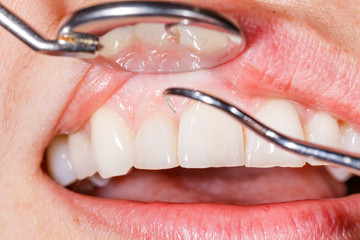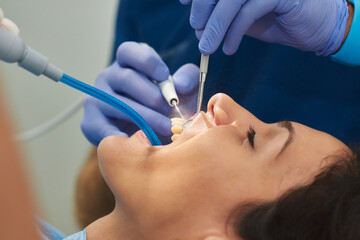Gums Procedure: What’s Method Are Required For It?

Gums Procedure There are several different procedures that may be referred to as “gum procedures.” These procedures may be used to address issues with the gums, such as gum disease, gum recession, or excess gum tissue. Some common gum procedures include:
- Scaling and root planing: This is a deep cleaning procedure that removes plaque and tartar from the teeth and roots. It is often used to treat gum disease, also known as periodontitis.
- Gum grafting: This procedure involves taking a small piece of gum tissue from another area of the mouth or using a synthetic material to cover an area of gum recession. Gum recession can occur due to periodontal disease, toothbrush abrasion, or other factors.
- Gum reshaping: This procedure involves removing excess gum tissue to expose more of the tooth and improve the appearance of the gums.
- Pocket reduction surgery: This procedure involves making small incisions in the gum tissue to expose and clean the roots of the teeth. It is often used to treat gum disease and can help reduce the depth of pockets between the gums and teeth.
It’s important to note that these procedures may be performed by a periodontist, a dental specialist who focuses on the treatment of the gums and supporting structures of the teeth. Your general dentist or a specialist can recommend the appropriate treatment for your specific needs.
What Is Gums Procedure:
A gum procedure is a type of dental treatment that is performed on the gums, and the soft tissue surrounding the teeth. Gum procedures are often used to address issues with the gums, such as gum disease, gum recession, or excess gum tissue. Some common gum procedures include scaling and root planing, gum grafting, gum reshaping, and pocket reduction surgery. These procedures may be performed by a periodontist, a dental specialist who focuses on the treatment of the gums and supporting structures of the teeth. Your general dentist or a specialist can recommend the appropriate treatment for your specific needs.
What’s Method Are Used In Gums Procedure:
There are several methods that may be used in gum procedures, depending on the specific issue being addressed and the preferences of the dental provider. Some common methods used in gum procedures include:
- Scaling: This method involves using a tool, such as a scaler or ultrasonic instrument, to remove plaque and tartar (hardened dental plaque) from the surface of the teeth and roots.
- Root planing: This method involves smoothing the roots of the teeth to remove rough or irregular areas that may harbor bacteria.
- Gum grafting: This method involves taking a small piece of gum tissue from another area of the mouth or using a synthetic material to cover an area of gum recession.
- Gum reshaping: This method involves removing excess gum tissue to expose more of the tooth and improve the appearance of the gums. This may be done using a laser or a scalpel.
- Pocket reduction surgery: This method involves making small incisions in the gum tissue to expose and clean the roots of the teeth. It may also involve smoothing the roots and filling the space between the gum and tooth (also known as a “pocket”) with a material to help reduce the depth of the pocket.
It’s important to note that these methods may be used alone or in combination, depending on the specific needs of the patient. Your dental provider will discuss the appropriate treatment options with you.

If you want to get amazing benefits by using this link
Conclusion:
In conclusion, gum procedures are a type of dental treatment that is performed on the gums, the soft tissue surrounding the teeth. These procedures may be used to address issues with the gums, such as gum disease, gum recession, or excess gum tissue. Some common gum procedures include scaling and root planing, gum grafting, gum reshaping, and pocket reduction surgery. These procedures may be performed by a periodontist, a dental specialist who focuses on the treatment of the gums and supporting structures of the teeth. There are several methods that may be used in gum procedures, depending on the specific issue being addressed and the preferences of the dental provider. Your dental provider will discuss the appropriate treatment options with you and help you determine the best course of action for your specific needs.

